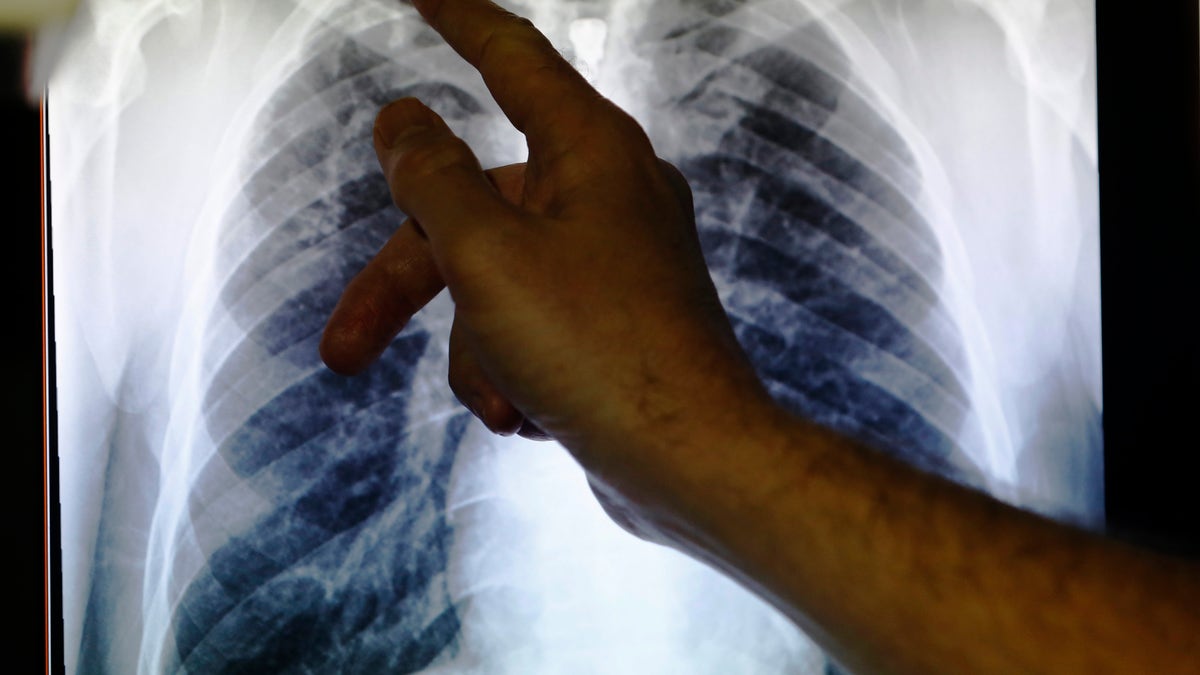
Jan 27, 2014 -Clinical Dr Al Story points to x-ray showing lungs infected with TB (tuberculosis) in London. (REUTERS)
With a half million new cases each year, multidrug-resistant tuberculosis (MDR-TB) is spreading around the globe. The world must act decisively. There can be no delay.
That is why on Dec 22, 2015, President Obama announced the National Action Plan for Combating Multidrug-Resistant Tuberculosis. It is a strong, unambiguous call for doctors, nurses, scientists, and health and political leaders worldwide to take rapid, focused action.
The danger MDR-TB carries is personal for me. I’ve personally overseen the treatment of more than 1,000 patients with MDR-TB, many of them with the even more dangerous extensively drug-resistant TB (XDR-TB). In the course of treating others, I became infected myself – likely with a drug-susceptible strain still easily treatable with antibiotics – and have taken treatment for latent infection so likely will never develop the disease.
But I’ve seen first-hand the emotional and physical toll drug-resistant TB inflicts on each patient, on families and entire communities, and on front-line health care workers. I remember my patients with XDR-TB vividly. We cured one patient who, as a result of the intensive drug regimen needed to save his life, lost enough eyesight and hearing that he couldn’t go back to his job repairing watches and was dejected by the loss of his livelihood. TB respects no borders. That’s why I’m insisting that governments and public health officials worldwide take urgent action.
Nearly a third of the world’s population is infected with TB bacteria. In 1993, the World Health Organization (WHO) declared TB to be a global health emergency. Since then, intensified efforts to detect and treat TB have cut global TB deaths in half. Yet every day, 4,000 people still die of this curable disease – one every 20 seconds. Now MDR-TB threatens more lives and could reverse the hard-fought progress we’ve made over the past two decades.
The Threat of MDR-TB
MDR-TB bacteria aren’t affected by the first-choice TB treatments that have saved tens of millions of lives over the past 15 years. Extensively drug-resistant TB (XDR-TB) is impervious to nearly all antibiotics. WHO estimates that there were nearly 500,000 MDR-TB cases and approximately 50,000 cases of XDR-TB globally last year. More than 190,000 people die each year from drug-resistant TB. We must take action now to stop this completely preventable disease.
Imagine for a moment you have MDR-TB. You face two years of treatment and will need to see a health provider nearly every day. You’ll receive 250 injections and 15,000 pills. The drugs most likely to cure you can have long-term side effects such as hearing loss and liver damage, and there’s a very real chance that even this exhausting treatment regimen won’t cure you. And treating MDR-TB patients in the United States is expensive, costing about $150,000. Treating XDR-TB is even more expensive – nearly half a million dollars, about 30 times more than the $17,000 it costs to treat regular, drug-susceptible TB.
The National Action Plan
Worldwide, only 1 in 5 people with MDR-TB get appropriate treatment. And only half of those treated are cured.
In our increasingly interconnected world a health threat anywhere is a health threat everywhere. This is particularly true for MDR-TB. The National Action Plan addresses the MDR-TB threat both in the U.S. and overseas. It has three major goals:
? Fight MDR-TB at home. We must make sure that every person in our country with TB gets appropriate treatment and that those who have been in close contact with infectious TB patients are monitored and, when necessary, also treated.
? Fight MDR-TB abroad. The U.S. is investing in broader access to diagnosis and treatment, engaging with providers in the most highly affected communities and countries, and developing innovative health technologies. We must accelerate accountable programs to diagnose and effectively treat every patient, for their sake and the world’s.
? Speed up research and development of new ways to prevent, diagnose and treat TB and MDR-TB.
The National Action Plan dovetails with major efforts already underway. For example, the Global Health Security Agenda, launched in 2014, aims to improve all nations’ ability to find, stop, and prevent disease outbreaks. More than 70 countries have joined the United States in this internationally-led effort.
And in March 2015, the White House announced the National Action Plan for Combating Antibiotic-Resistant Bacteria, strengthening efforts to slow the emergence and spread of treatment-resistant diseases such as MDR-TB.
Fighting TB – especially MDR-TB – is a high priority at CDC. Our Division of Tuberculosis Elimination and Division of Global HIV and TB work to find and cure all TB patients in the U.S. while improving international TB control efforts by strengthening laboratory and surveillance networks, building a public health workforce through training and mentorship, and developing new tools and approaches to address TB and MDR TB in more than 25 countries.
But we can’t do it alone. MDR-TB and XDR-TB strains emerge and spread every day, and this global threat requires a full-scale global response. The clock is ticking.
